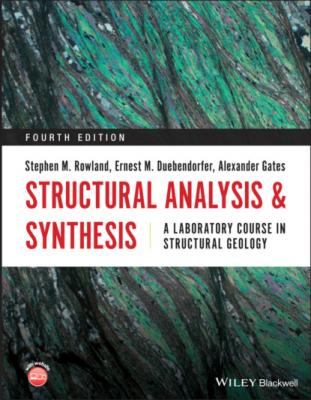ТОП просматриваемых книг сайта:
Structural Analysis and Synthesis. Stephen M. Rowland
Читать онлайн.Название Structural Analysis and Synthesis
Год выпуска 0
isbn 9781119535485
Автор произведения Stephen M. Rowland
Жанр География
Издательство John Wiley & Sons Limited
5 Planes/contacts that dip downstream at the same dip angle as the stream gradient appear parallel to the stream bed (Figure 2.5).Figure 2.1 Horizontal layer in a stream valley. (a) Block diagram. (b) Map view.Figure 2.2 Vertical layer strikes perpendicular across a ridge and valley. (a) Block diagram. (b) Map view.Figure 2.3 Inclined layer strikes perpendicular across a horizontal ridge. (a) Block diagram. (b) Map view.
6 Planes/contacts that dip downstream at a gentler angle than the stream gradient “V”/point upstream (Figure 2.6).
7 Planes/contacts that dip downstream at a steeper angle than the stream gradient (the usual case) “V”/point downstream (Figure 2.7).
Figure 2.4 Inclined layer dipping upstream that flows 90° to strike. (a) Block diagram. (b) Map view.
Figure 2.5 Layer dipping parallel to stream gradient (perpendicular strike). (a) Block diagram. (b) Map view.
Figure 2.6 Layer dipping downstream more gently than the stream gradient with strike perpendicular to stream. (a) Block diagram. (b) Map view.
Figure 2.7 Layer dipping downstream more steeply than the stream gradient; stream perpendicular to strike. (a) Block diagram. (b) Map view.
On the geologic map in Figure P2.1, draw the correct strike and dip symbol in each circle to indicate the attitude of Formation B and each dike. To verify your attitude symbols, Figure P2.2 can be cut out and folded to form a block model of this map. Table 1.1 shows standard symbols for geologic maps.
Structure Contours
On a topographic map, contour lines connect points of equal elevation on the earth's surface. In contrast, structure contour is a line that connects points of equal elevation from sea level on a structural surface, such as the top of a bed or formation (Figure 2.8). This means that the orientation of a structure contour is parallel to the strike of the bed or other structural element. Dip direction is perpendicular to the structure contour and directly downslope. Structure contours are read and analyzed the same way as topographic contours, in most cases. For example, calculating dip angles is done the same way as calculating slope angles from topographic contours. Both use the formula:
Structure‐contour maps are used for depiction and recognition of features in the subsurface. They are used extensively in petroleum exploration to identify structural traps and in hydrology to characterize the subsurface configurations of water tables and aquifers. Although there are more sophisticated methods to model the hydrogeology of an area, structure contouring of the water table is an invaluable skill for all geologists working on environmental delineation/remediation projects.
Figure 2.8 Example of structure contours on a structural surface.
Structure‐contour maps are commonly constructed from drill‐hole data. See Figure 2.9, for example, which shows a faulted dome. Notice that, unlike topographic contours, structure contours can terminate abruptly. Gaps in the map indicate normal faults, and overlaps indicate reverse faults.
There are various techniques for contouring elevations. In the case of structure contours, there are usually not enough data to produce an unequivocal map, so experienced interpretation is valuable. Although there are computer programs that draw contour lines between data points, such programs cannot substitute for the judgment of an experienced geologist.
Figure 2.9 Block diagram (a) and structure‐contour map (b) of a subsurface faulted structural dome with contours on the top of shaded layer. D, down; U, up.
The Three‐Point Problem
Step‐by‐Step Solution
1 Label the three known points A, B, C and their elevations on the map.
2 Draw lines connecting the three points and making a triangle.
3 One of the lines connects the highest to the lowest of the three points. Scale this

